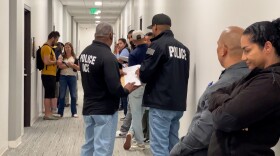Much is still unknown about the coronavirus, including a full picture of perhaps its most important impact: who it has killed.
The Centers for Disease Control and Prevention says that "current data suggest a disproportionate burden of illness and death among racial and ethnic minority groups." The death toll is also incomplete, because not everyone who dies of COVID-19 is counted under that cause of death, among other reasons.
Racial, ethnic and socioeconomic data about people who have died of COVID-19 are not all readily available either. So researchers at Harvard instead looked at the cities, towns and ZIP codes of people who have died of all causes. They compared the number of people who have died against what would be expected in a normal year, or "excess deaths."
What they found is "inequality on top of inequality," says Jarvis Chen, a social epidemiologist at the Harvard T.H. Chan School of Public Health.
The team of researchers looked specifically at Massachusetts. Areas with "widespread economic segregation and heavy concentrations of poverty, people of color, and crowded housing" had higher mortality rates compared with everywhere else from the beginning of the year through April 15, they found.
"These are communities in which people may be working 'essential jobs,' where they're unable to practice physical distancing," Chen tells NPR's Mary Louise Kelly.
"These are communities where people are living in crowded conditions so that if one person in a household gets infected, it's very difficult for them to isolate and protect the other people in their households," he explains. "These are also communities in which people may not be getting access to testing or to care. And so that increases their risk of dying if they do get infected."
Chen and his colleagues say the findings help governments and support groups target their efforts to stem the virus's spread over the next year.
"We're probably going to see more waves as we go through this next year. And so knowing what we did and what we did wrong the first time around will help us understand better how to direct the resources," Chen says.
"So, for example, creating resources for people in communities to be able to isolate. So housing or temporary housing for people who test positive so that they can protect their families is really important," he says. "Knowing where to direct PPE as it becomes more available so that not just the essential workers in hospitals, but also essential workers in things like public transportation or grocery store workers, those populations can get the PPE that they need. And also directing testing to communities who need it the most. Those things could be really important."
Listen to the full interview at the audio link above.
Copyright 2020 NPR. To see more, visit https://www.npr.org.






